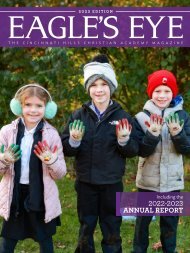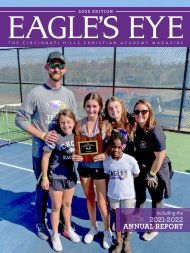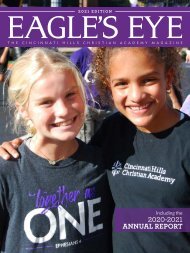Mission, Vision, Competencies, Standards, and Benchmarks
A Statement of Curriculum CINCINNATI HILLS CHRISTIAN ACADEMY Edyth B. Lindner Campus Otto Armleder Memorial Education Center Founders’ Campus Martha S. Lindner Campus 2019 Edition
A Statement of Curriculum
CINCINNATI HILLS CHRISTIAN ACADEMY
Edyth B. Lindner Campus
Otto Armleder Memorial Education Center
Founders’ Campus
Martha S. Lindner Campus
2019 Edition
Create successful ePaper yourself
Turn your PDF publications into a flip-book with our unique Google optimized e-Paper software.
Comparisons<br />
‣ Locating places on the China map, recognizing the Chinese school system, family<br />
system, name places in the family house <strong>and</strong> learning about the Chinese living style.<br />
Communities<br />
‣ Practicing conversations with neighbors, Christian Church celebrations, Chinese New<br />
Year.<br />
Chinese II<br />
By close of Chinese II the student will work to master:<br />
Communication<br />
‣ Recognizing <strong>and</strong> count currency, name clothes, receiving <strong>and</strong> giving directions, talk<br />
about sports seasons, name transportation, name body parts, converse using<br />
situations such as borrowing the car, party invitation, not feeling well, rent an<br />
apartment.<br />
Culture<br />
‣ Demonstrating knowledge <strong>and</strong> underst<strong>and</strong>ing of perspectives, practices, <strong>and</strong> products<br />
of China <strong>and</strong> Chinese speaking cultures.<br />
Connections<br />
‣ Reinforcing <strong>and</strong> acquiring knowledge of other disciplines through M<strong>and</strong>arin Chinese,<br />
such as the study of literature, media, advertisements, <strong>and</strong> others.<br />
‣ Acquiring information <strong>and</strong> recognizing the distinctive viewpoints available only through<br />
M<strong>and</strong>arin Chinese <strong>and</strong> the Chinese culture.<br />
Comparisons<br />
‣ Developing insight into the nature of language <strong>and</strong> culture through comparisons.<br />
Communities<br />
‣ Using M<strong>and</strong>arin Chinese both within <strong>and</strong> beyond the school setting.<br />
Chinese III<br />
By close of Chinese III the student will work to master:<br />
Communication:<br />
Three Modes of Communication for the intermediate learner [from ACTFL performance<br />
st<strong>and</strong>ards]: The intermediate learner requires instruction gradually adding more sophisticated<br />
vocabulary <strong>and</strong> grammatical structures, helping learners get ready for advanced Chinese<br />
study by introducing formal <strong>and</strong> written expressions <strong>and</strong> increasing students’ “media literacy.”<br />
Instruction provides exposure to common Chinese idioms <strong>and</strong> the stories behind them, <strong>and</strong><br />
includes texts written in the style of newspaper, magazines, <strong>and</strong> Internet news articles:<br />
‣ Interpersonal<br />
‣ Interpretive<br />
‣ Presentational<br />
Six Domains of Performance<br />
‣ Comprehensibility (How well is the student understood?)<br />
‣ Comprehension (How well does the student underst<strong>and</strong>?)<br />
‣ Language Control (How accurate is the student's language?)<br />
‣ Vocabulary Usage (How extensive <strong>and</strong> applicable is the student's language?)<br />
Back to Table of Contents


















